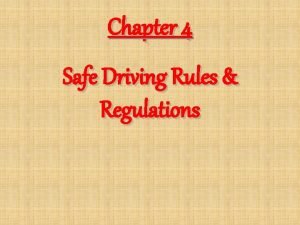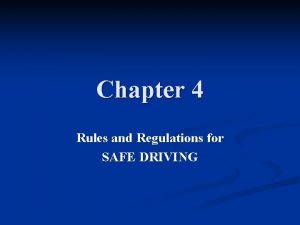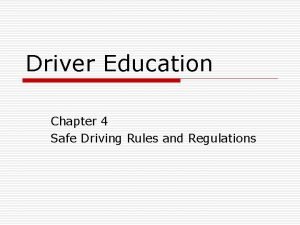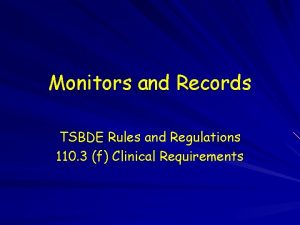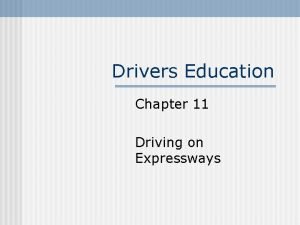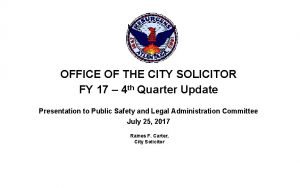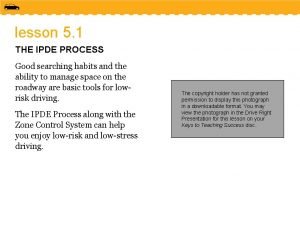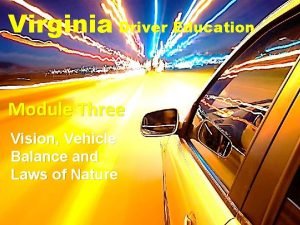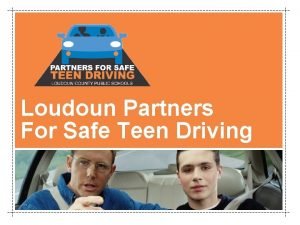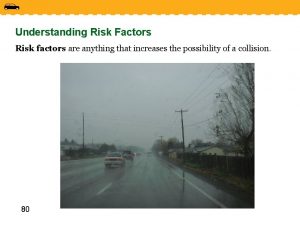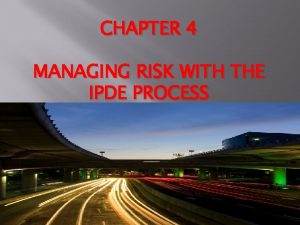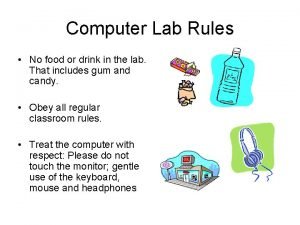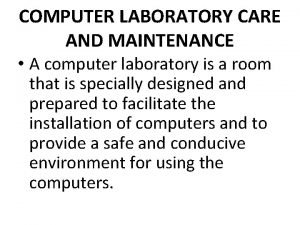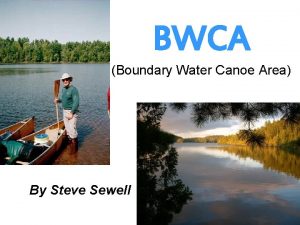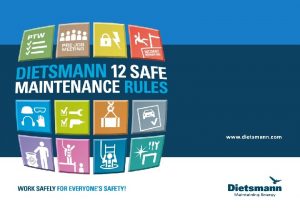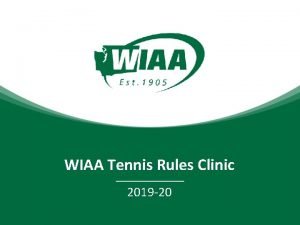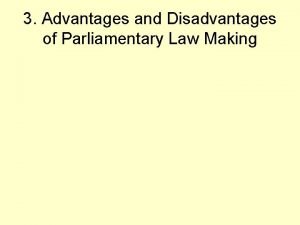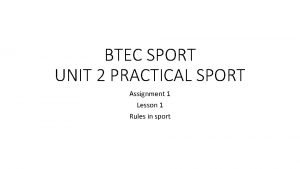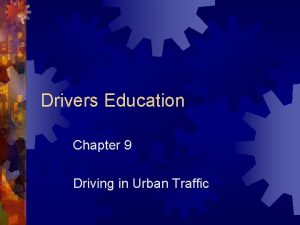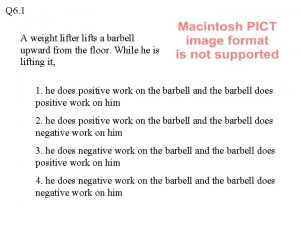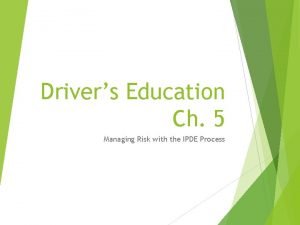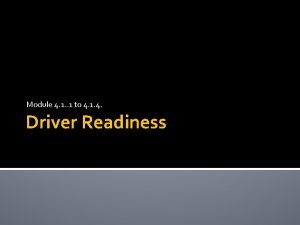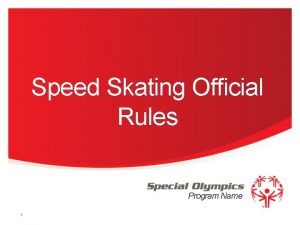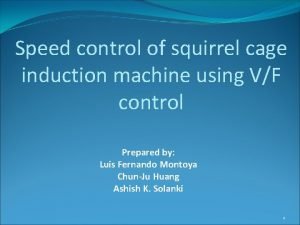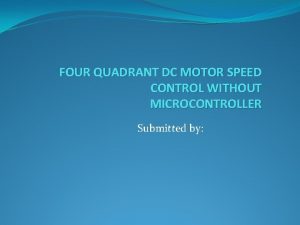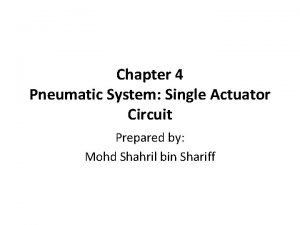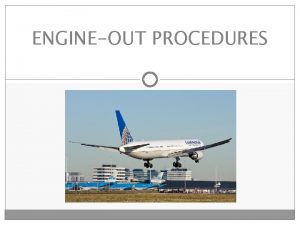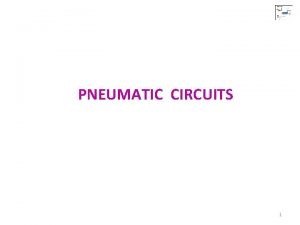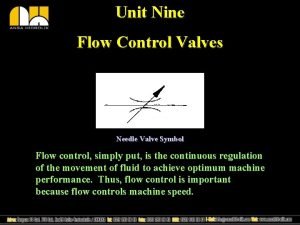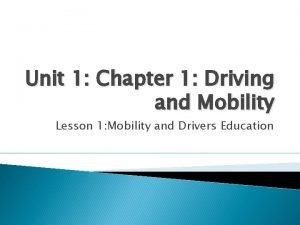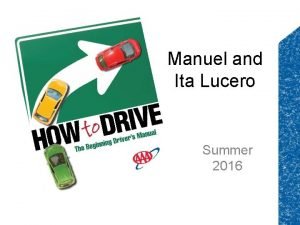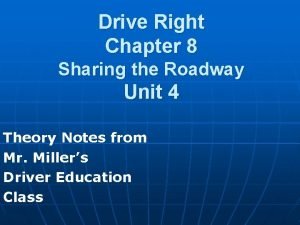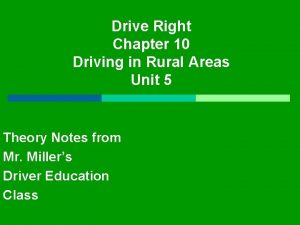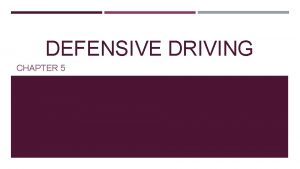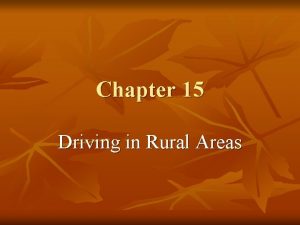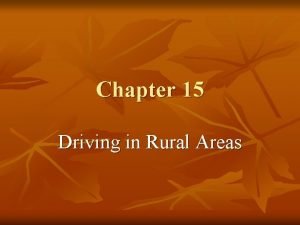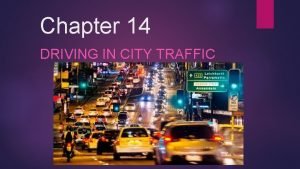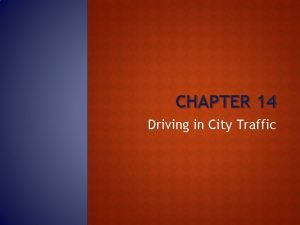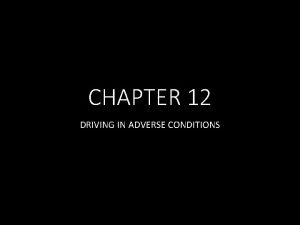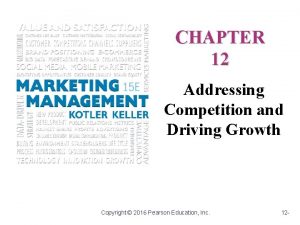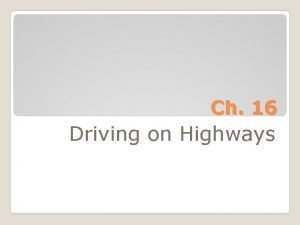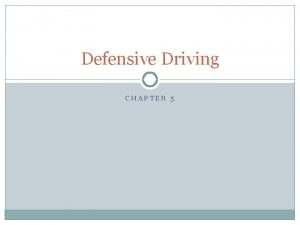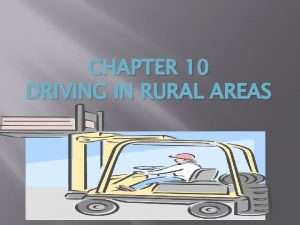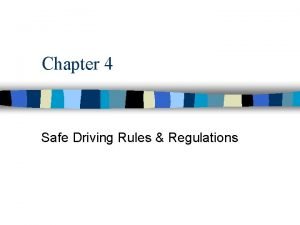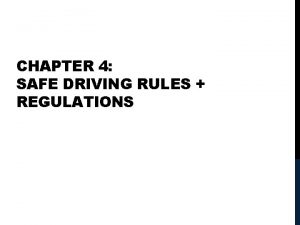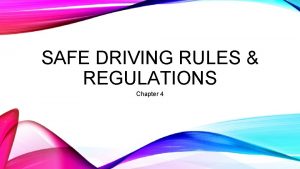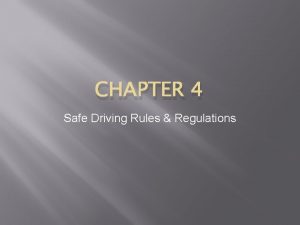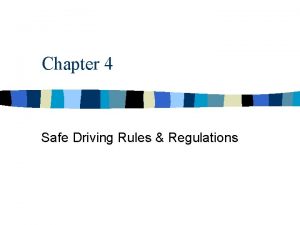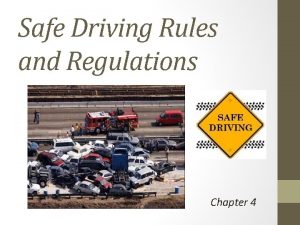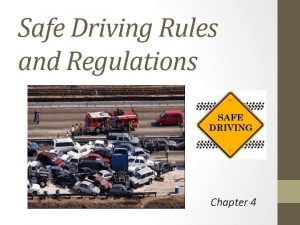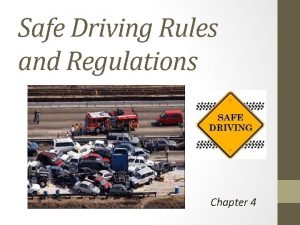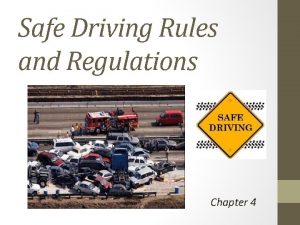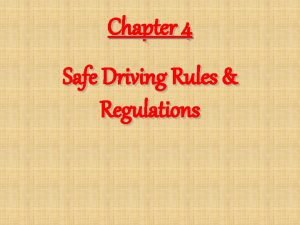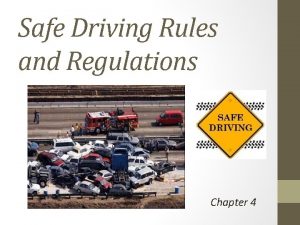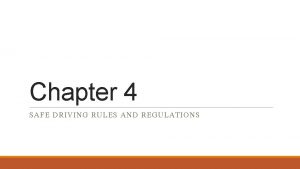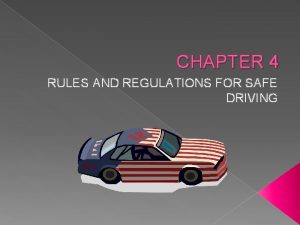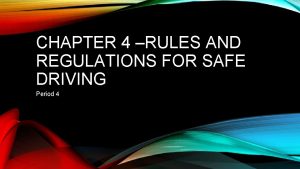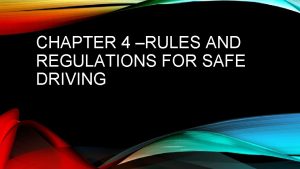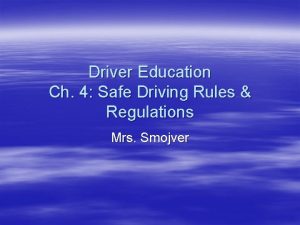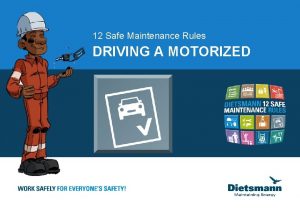Chapter 4 Safe Driving Rules Regulations SPEED CONTROL

























































- Slides: 57

Chapter 4 Safe Driving Rules & Regulations

SPEED CONTROL The Law n n n Exceeding the speed limit is cause for most accidents Always obey speed limit Speed affects EVERYTHING while driving Always keep with flow of traffic Keep your distance


Speed Limits n School Zone, Business and Residential Districts n Suburban Business and residential areas

Speed Limits (cont. ) n Non-posted rural roadways n Certain state highways (as posted) and all other interstates

Speed Limits (cont. ) n Certain Interstate Highways (as posted) Note- Drivers pay double fines for exceeding a 65 mph limit by 10 mph or more. Double fines also apply to most other moving violations committed in 65 mph zone.

Speed Control n n n Never drive faster than weather, or road conditions allow you to Regardless of speed limit Judge your speed by existing road conditions Motorists should slow to see clearly and stop quickly Failure to do so may result in a moving violation

When should you slow down while driving?

You Should Slow Down When… n n n You are on a winding or narrow road At an intersection or railroad crossing On hills At sharp or blind curves Where pedestrians or driving hazards are present On wet or slippery roads

Driving too Slowly n n n Keep up with normal flow of traffic without exceeding the posted speed limit Slow driving can cause collisions When road surfaces and traffic are normal, NJ law prohibits blocking traffic through slow driving

Safe Corridors n Doubles fines for – Speeding – Aggressive driving n Placed in areas with high accident rates

Passing n Stay to the right of center lines n Passing is only safe when there is no oncoming traffic n Watch for lane makings

Lane Markings

Lane Markings

Most passing should be made on the left. Pass on the right only when roads have more than one lane going in the same direction or the driver ahead of you is turning left. New Jersey law prohibits passing on the right shoulder of the roadway.

*on a hill or a curve, or at any time sight lines are impeded *at a street crossing or intersect *at a railroad crossing *on narrow bridges, or in an underpass and tunnels *when a sign prohibits passing or center lines restrict passing *when behind a vehicle that has stopped to let a pedestrian cross

New Jersey law requires driver to keep to the right, except when passing. Drive as closely as possible to the right -hand edge or curb of the roadway, except when passing another vehicle.

Yielding the Right of Way n n n Emergency Vehicles: Always yield to police cars, fire engines, and ambulances when they are giving warning signs such as flashing sirens and lights. Buses: when re-entering the flow of traffic Postal Vehicles: when re-entering the flow of traffic Pedestrians: when in a crosswalk Motorized devices: in a crosswalk Other vehicles already in the intersection

Intersections n n n Where two or more roads intersect Most accidents occur at intersections Single solid white line across your lane means you must stop behind that line

Controlled Intersections n n n Always yield to the driver on your right if arriving at a four-way stop Always yield to any driver at or in an intersection When making a left turn at an intersection, yield to oncoming traffic and all pedestrians within a crosswalk

Uncontrolled Intersections n n Motorists entering the intersection from a private road or driveway must yield to all traffic on the main road. Vehicle on left should yield to vehicle on the right Reduce speed and be ready to stop if traffic is coming from left or right If a traffic light is out treat it as a 4 way stop

Blind Intersections n n Buildings, parked cars, trees, crops, and bushes can obstruct motorists’ line of sight. Slow down or stop completely to make sure there is no cross traffic before proceeding.

Traffic Circle n n No set rules for a circle Major road has right of way Traffic signs control Person to left yields to person on right

Entering Highways, Parkways, and Turnpikes - Acceleration Lane: used to speed up to join flow of traffic - Obey posted speed limits - Speed up to the flow of traffic - Try to avoid coming to a complete stop in the acceleration lane - Yield to traffic and enter the right-hand lane when safe

Leaving Highways, Parkways, and Turnpikes n Deceleration Lane: used to slow down when exiting – Start Slowing down when entering deceleration lane – Obey the posted speed – If you miss an exit take the next one – Never back up on exit ramp

Warm-up n Do you think it should be against the law to use your cell phone while driving?

Curves n n n Vehicle will tend to keep going straight Slow down before entering the curve Do not drift into other lanes

Interchange n Cloverleaf is used to enter/exit express traffic roads.

Right Turn On Red n n n Do not turn right when there is a no turn on red sign. Come to a complete stop. Watch all oncoming traffic and pedestrians

Right Turns n n n Get into right hand lane Signal right turn Slow down to turn Do not make a wide turn Do not cross lane markings

Left Turn n n n Signal left turn keep close to center line Yield to oncoming traffic Turn into left lane Do not cut corner Don’t cross lane markings

Other Left Turns n n n Signal left turn keep close to center line Yield to oncoming traffic Turn into the nearest left bound lane May cross solid center lines to turn left between intersections

n n Never try to beat a traffic light Be careful when at a fresh green light Most accidents occur in the first few seconds of a light changing Stop at yellow light following a green light

Running a Red n http: //www. youtube. com/watch? v=Wfjq Mu. R 8 o. Yo

Stopping at Railroad Crossings n n Motorist must stop at least 15 ft. from railroad crossing when there are lights flashing, bells, or flag signals Never attempt to cross until gates have been raised and lights have stopped flashing Commercial Vehicles must stop at all railroad crossings Never stop on the tracks

Not stopping at railroad n http: //www. youtube. com/watch? v=O 76 i mb 5 z 5 z. U

Stopping for school buses n n You must stop for a school bus with flashing red lights State law requires that a motorist stop a least 25 ft. Away if traveling on a 2 lane road, or on a multi-lane highway where lanes are only separated by lines, or on a privately maintained road

Stopping for school buses cont. n n When traveling on a dual lane highway you can pass at 10 mph if on the other side of the raised or island median If a school bus has stopped directly in front of a school to pick up or let off children, pass from either direction no more than 10 mph.

Stopping for Desert Trucks

-Yield to the right of way to any person who is crossing the street to or from the vehicle. -Watch out for children and be prepared to stop. -Never drive past the vehicle at a speed faster than 15 M. P. H. -You don’t have to stop on a dual highway when traveling on the other side of a safety island or raised median

Stopping for Emergency Vehicles

-New Jersey requires motorists to yield to emergency vehicles sounding or flashing red or blue lights -Steer to extreme right -Wait for the vehicle to pass -Keep 300 ft. behind emergency vehicle -Do not park 200 ft within fire department vehicle

Using Headlights • Headlights must be turned on one half hour after sun set and one half hour before sunrise. • They must also be used when it is snowing, raining, and any precipitation that might be falling from the sky.

There are two different settings when it comes to headlights. The first, is the dim lights or the everyday driving lights. They are used when there are other vehicles are around. The other type is high beams, used for open country driving and when other cars are not in the area.

Parking Regulations & Littering

Before exiting a vehicle: n n n Check for bicycles and mopeds and other hard to see object. Look for all parking related signs for parking restrictions. It’s illegal to park more than 6 in. from the curb.

Do NOT Park: n n n On crosswalks between a safety zone for pedestrians or 20 feet from the end of a safety zone near street construction in a handicapped space on an interstate highway n n n In a bus stop zone in front of a public/private driveway with an intersection within 10 feet of a fire hydrant within 25 feet of a crosswalk or intersection

Do NOT Park n n Within 20 feet of the driveway entrance to any fire station entrance Within 50 feet of a stop sign on any bridge or tunnel next to another vehicle parked at the curb


n As of July 1, 2004, hand held cell phones were not permitted at the wheel

Cell phone use n http: //www. youtube. com/watch? v=a. Pln Na. HGZY 8

~traffic accident ~Fire

~Serious Road Hazard ~medical emergency

And Hazardous material emergency --> Drivers in these situations would still have to keep their hands on the wheel <--

To prove that these situations happened, drivers would have to bring in written statement, witness testimony, and phone records The fine for breaking this law in $100 to $250

Show Europe Texting PSA http: //video. google. com/videosearch? q=texting+while+driv ing+commercial&www_google_domain=www. google. com& emb=0&aq=1&oq=texting+#

Littering n n n Throwing trash from a vehicle is illegal up to $1, 000 fines driver’s license could be suspended.
 A motorist should know that he/she is entering
A motorist should know that he/she is entering Chapter 4 safe driving rules and regulations
Chapter 4 safe driving rules and regulations Chapter 4 safe driving rules and regulations
Chapter 4 safe driving rules and regulations Controlled uncontrolled and blind intersections
Controlled uncontrolled and blind intersections Strong emotions can interfere with your ability to
Strong emotions can interfere with your ability to Head tilt chin lift jaw thrust
Head tilt chin lift jaw thrust How do you think wolf packs form on expressways
How do you think wolf packs form on expressways Ptit safe driving and awareness course online
Ptit safe driving and awareness course online What are the four steps in the ipde process
What are the four steps in the ipde process Allows maximum stopping force without locking up the brakes
Allows maximum stopping force without locking up the brakes Partners for safe teen driving
Partners for safe teen driving Orderly visual search pattern
Orderly visual search pattern Chapter 4 managing risk with the ipde process
Chapter 4 managing risk with the ipde process Safe feed safe food
Safe feed safe food Safe people safe places
Safe people safe places Badminton rules and regulations
Badminton rules and regulations Class rules and regulations
Class rules and regulations No food or drink near computers
No food or drink near computers Child care facility rules and regulations
Child care facility rules and regulations Preventive maintenance in computer laboratory
Preventive maintenance in computer laboratory Bwca rules and regulations
Bwca rules and regulations Maintenance rules
Maintenance rules Tennis rules and regulations 2019
Tennis rules and regulations 2019 Advantages and disadvantages of rules and regulations
Advantages and disadvantages of rules and regulations Rto rules and regulations
Rto rules and regulations Btec sport level 3 unit 2
Btec sport level 3 unit 2 Chapter 9 driving in urban traffic answers
Chapter 9 driving in urban traffic answers J3mamvpabeo -site:youtube.com
J3mamvpabeo -site:youtube.com A tractor driving at a constant speed
A tractor driving at a constant speed Formula for speed distance and time
Formula for speed distance and time Speed detection of moving vehicle using speed cameras ppt
Speed detection of moving vehicle using speed cameras ppt 4 golden rules of gun safety
4 golden rules of gun safety Chapter 5 managing risk with the ipde process
Chapter 5 managing risk with the ipde process What can you do to control your emotions while driving
What can you do to control your emotions while driving Speed skating rules
Speed skating rules Speed control of squirrel cage induction motor
Speed control of squirrel cage induction motor Four quadrant dc motor control without microcontroller
Four quadrant dc motor control without microcontroller Indirect control of single acting cylinder
Indirect control of single acting cylinder Minimum control speed
Minimum control speed Single acting cylinder diagram
Single acting cylinder diagram Orifice valve symbol
Orifice valve symbol How is the hts regulated
How is the hts regulated Chapter 1 managing risk when driving
Chapter 1 managing risk when driving Chapter 16 driving on highways
Chapter 16 driving on highways Alcohol is the most commonly used drug in our society
Alcohol is the most commonly used drug in our society To protect a tailgating motorcyclist
To protect a tailgating motorcyclist Drive right chapter 10 answer key
Drive right chapter 10 answer key In extreme cases an aggressive driver may
In extreme cases an aggressive driver may Chapter 15 driving in rural areas
Chapter 15 driving in rural areas Rural areas have of development drivers ed
Rural areas have of development drivers ed Chapter 14 driving in city traffic
Chapter 14 driving in city traffic Why is city driving more difficult
Why is city driving more difficult Driving in adverse conditions chapter 12
Driving in adverse conditions chapter 12 Addressing competition and driving growth ppt
Addressing competition and driving growth ppt 5.2 driving in adverse conditions assignment
5.2 driving in adverse conditions assignment Describe velocitation and highway hypnosis
Describe velocitation and highway hypnosis Chapter 5 defensive driving
Chapter 5 defensive driving Chapter 10 driving in rural areas
Chapter 10 driving in rural areas
